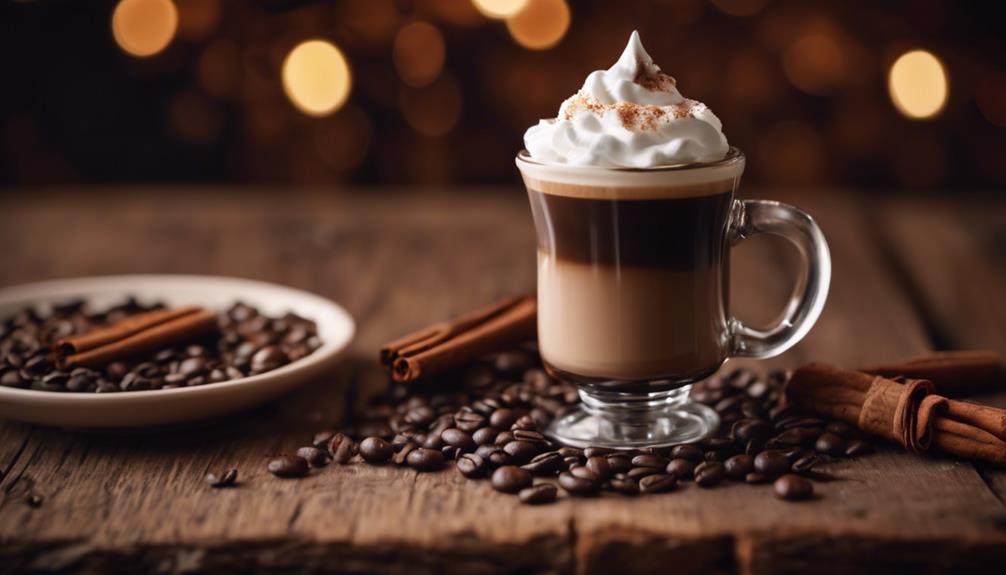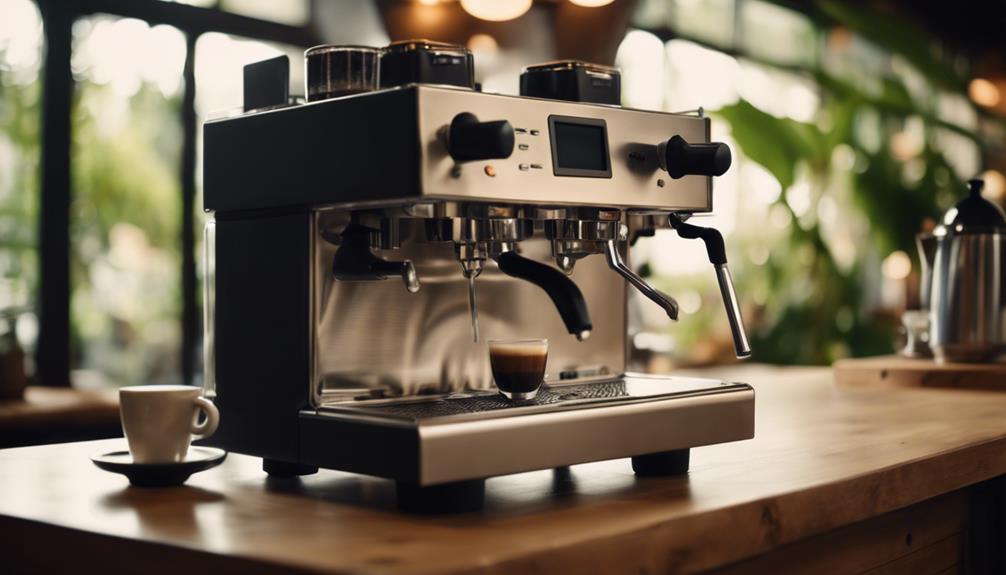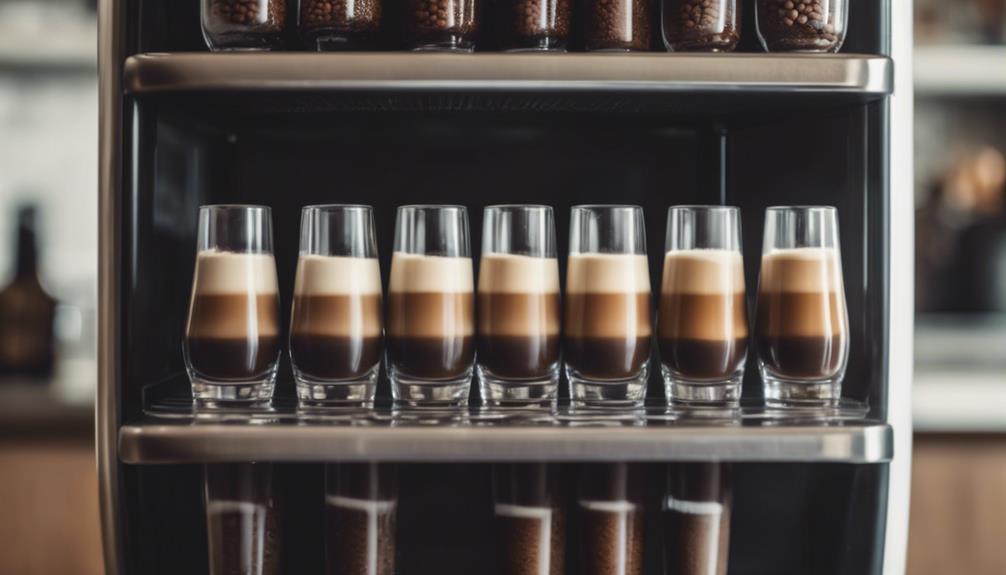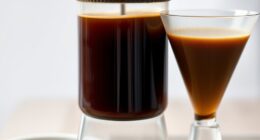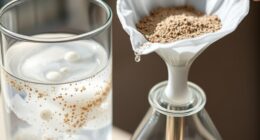You may be curious if espresso is simply a more potent version of coffee, but in reality, it is a unique brew with its own special characteristics. From the high-pressure brewing method to the finer grind size and bolder flavor profile, espresso distinguishes itself from regular coffee. With a higher caffeine content and specialized equipment, it’s no surprise that espresso has garnered a devoted following. However, there is more than meets the eye – as you delve into the realm of espresso, you will uncover the intricacies that make it unique and explore the methods and subtleties that elevate it to a true artisanal craft.
Key Takeaways
- Espresso is brewed using high pressure and a finer grind size, resulting in a concentrated beverage with a richer flavor profile.
- The coffee-to-water ratio for espresso is 1:2, compared to 1:18 for regular coffee, affecting consistency and flavor concentration.
- Espresso machines utilize high pressure for rapid brewing, producing a beverage with a thick crema and bold flavors.
- Despite its higher concentration, espresso often has less total caffeine than brewed coffee due to smaller serving sizes.
Understanding Coffee and Espresso Basics
As you explore the world of coffee, it's vital to understand the fundamental differences between regular coffee and espresso. Regular coffee is brewed with hot water passing through ground coffee beans using a filter, resulting in a larger, more diluted cup of coffee. Espresso, on the other hand, is made with a small amount of hot water being forced through finely ground coffee beans at high pressure, producing a concentrated shot of coffee. When choosing the right coffee, it’s important to consider your preferred taste and strength, as well as the brewing method that best suits your lifestyle and needs. Whether you opt for a smooth and mellow cup of drip coffee or a bold and intense shot of espresso, understanding the differences will help you make the perfect choice for your daily coffee fix.
One key distinction lies in the brewing process. Espresso is created by forcing hot water through finely ground coffee at high pressure, resulting in a concentrated shot with a layer of crema on top. In contrast, regular coffee can be brewed using various methods like drip or pour-over, relying on gravity.
This difference in brewing affects the coffee-to-water ratio, with espresso using a 1:2 ratio and regular coffee using a 1:18 ratio, resulting in a thicker consistency in espresso.
When it comes to the beans themselves, espresso beans are roasted longer and darker than those intended for regular coffee, contributing to distinct flavor profiles. The roast level of espresso beans is typically darker, which enhances the bold and rich flavor of espresso.
Understanding these differences between coffee and espresso is essential in appreciating the unique characteristics of each beverage.
Key Differences in Brewing Techniques
As you explore the world of coffee and espresso, you'll notice that the brewing techniques couldn't be more different.
You'll need to use an espresso machine, which is specifically designed to create high pressure and precise temperature control, unlike drip coffee makers that rely on simpler methods.
Now, let's take a closer look at how these differences in machinery, pressure, and grind size impact the final product.
Espresso Machines Vs. Drip
You're likely familiar with the two most popular brewing methods: espresso machines and drip coffee makers, but do you know what sets them apart when it comes to brewing techniques? The answer lies in the way they extract flavors from ground coffee beans.
Here are the key differences:
- Pressure and Time: Espresso machines use high pressure (around 15 bars) to extract coffee in just 20-30 seconds, while drip coffee makers rely on gravity, taking 6-12 minutes to brew.
- Grind Size and Flavor: Espresso requires a fine grind for ideal extraction, resulting in a rich, concentrated shot, whereas drip coffee uses a medium-coarse grind, producing a larger, less concentrated beverage.
- Water-to-Coffee Ratio and Caffeine: Espresso machines use a 1:2 water-to-coffee ratio, resulting in a higher caffeine concentration, whereas drip coffee makers use a 1:18 ratio, producing a less caffeinated brew.
These differences in brewing techniques have a significant impact on the flavor, texture, and caffeine content of your coffee.
High Pressure Brewing Methods
Forcing hot water through finely-ground coffee at high pressure, typically around 9 bars, yields a concentrated beverage with rich crema, a hallmark of high-pressure brewing methods like espresso.
When you brew espresso, you're using a process that's fundamentally different from traditional coffee brewing. The high pressure and finely ground coffee come together to create a unique extraction process that's both swift and intense.
This process takes only 20-30 seconds, compared to the 6-12 minutes it takes to brew coffee. The water-to-coffee ratio is also drastically different, with espresso using a 1:2 ratio versus coffee's 1:18.
This results in a beverage that's not only stronger but also has a bolder flavor profile. The high-pressure brewing method requires precision techniques like tamping and dosing to guarantee peak extraction, which isn't necessary for traditional coffee brewing.
The end result is a distinctive beverage that's thicker and more concentrated than brewed coffee.
Finer Grind Size Matters
When brewing espresso, you need to grind your coffee beans to an extremely fine texture, similar to sand, to guarantee ideal extraction under the high pressure of the espresso machine. This finer grind size is essential because it allows for a higher surface area, facilitating quicker extraction of flavors and oils during the brewing process. As a result, you'll get a richer and more concentrated shot.
Here's why a finer grind size matters:
- Flavors released: With a finer grind, more flavors and oils are extracted, giving you a richer and more complex taste experience.
- Faster extraction: The shorter extraction time of 20-30 seconds is made possible by the finer grind, which allows for optimal flavor extraction in a short period.
- Packed grounds: The compact coffee bed created by the fine grind can withstand the high pressure of the espresso machine, ensuring a perfect shot every time.
Espresso Machines and Coffee Makers
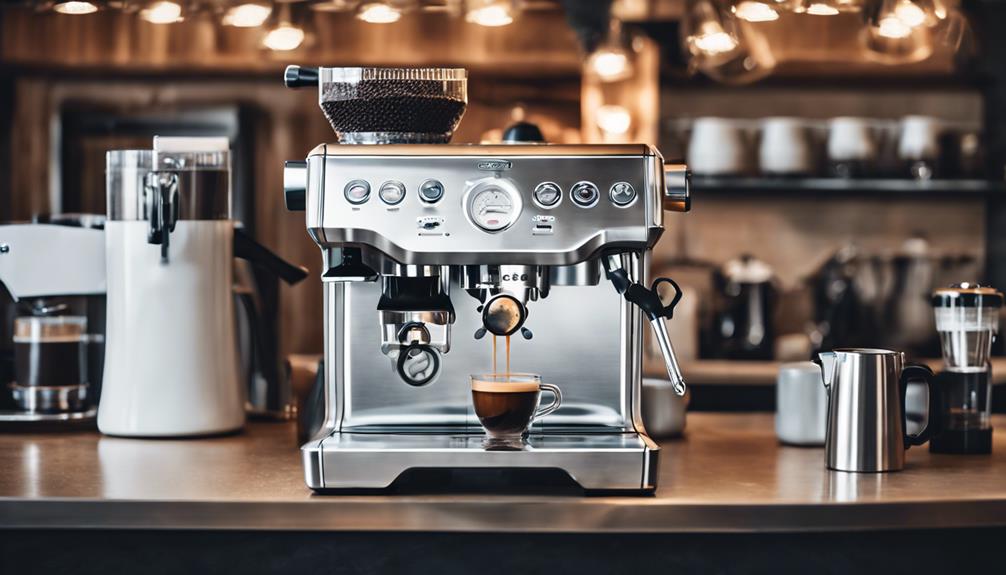
When it comes to making espresso, you'll need to contemplate the type of machine that's right for you.
You'll have to decide between automatic and semi-automatic options, each with their own benefits and drawbacks.
As you explore your choices, think about the brewing time and pressure that will give you the perfect shot.
Espresso Machine Options
How do you choose the perfect espresso machine from the numerous options available, taking into account your desired level of control and convenience?
With so many types of espresso machines out there, it's important to know what you want. Do you prefer a fully automatic machine that simplifies the brewing process, or a semi-automatic one that gives you more control over the shot?
Some key features to bear in mind when selecting an espresso machine include:
- Customizable shot dosage to create your perfect cup
- Automation options to streamline the brewing process
- High-quality construction to guarantee durability and longevity
Investing in a quality espresso machine can elevate your home brewing experience, allowing you to experiment with various recipes and techniques.
Automatic Vs. Semi-Automatic
You're faced with an essential decision when selecting an espresso machine: do you opt for the convenience of an automatic model or the control of a semi-automatic one? This choice affects your brewing process and the quality of your espresso drink.
Here's a breakdown of the key differences:
| Feature | Automatic Espresso Machines | Semi-Automatic Espresso Machines |
|---|---|---|
| Brewing Process | Handles entire process, including grinding and tamping | Requires user to grind and tamp coffee |
| Control | Limited control over brewing parameters | Offers more control over extraction time and pressure |
| Convenience | One-touch operation, ideal for busy users | Requires more user involvement |
| Customization | Limited customization options | Allows for customization of brewing parameters |
Automatic espresso machines are perfect for those who want a hassle-free experience, while semi-automatic machines offer more control and customization options for coffee enthusiasts. Coffee makers, on the other hand, use a different brewing method and are designed for larger quantities of coffee. Consider your needs and preferences when choosing between these options.
Brewing Time and Pressure
Now that you've reflected on the type of espresso machine that suits your needs, it's time to explore the brewing time and pressure that sets espresso apart from coffee made with coffee makers.
The brewing time is a significant factor in the difference between espresso and coffee. Espresso machines utilize high pressure, around 15 bars, to force hot water through finely-ground coffee in 20-30 seconds, resulting in a concentrated shot with a rich crema. In contrast, coffee makers rely on gravity, allowing water to seep through medium-coarse coffee grounds over a longer brewing period of 6-12 minutes.
Here are some key takeaways to evaluate:
- Lightning-fast brewing time: Espresso machines can produce a shot in under 30 seconds, while coffee makers take around 6-12 minutes.
- Pressure makes the difference: Espresso machines use high pressure to extract flavors, resulting in a bold and rich taste.
- Flavor profile: The quick brewing time of espresso contributes to its bold flavor profile, while the slower process in coffee makers allows for a lighter, more diluted taste.
Caffeine Content and Serving Sizes
When it comes to caffeine content, a key difference between espresso and coffee lies in their serving sizes, which can greatly impact the total amount of caffeine you ultimately consume. While espresso packs a punch with approximately 64 mg of caffeine per ounce, brewed coffee has about 11.5 mg of caffeine per ounce. However, since coffee is typically served in larger portions, you may end up consuming more caffeine overall.
Here's a breakdown of the caffeine content in different types of coffee:
| Type of Coffee | Caffeine per Ounce | Serving Size | Total Caffeine Intake |
|---|---|---|---|
| Espresso | 64 mg | 1 oz | 64 mg |
| Brewed Coffee | 11.5 mg | 8 oz | 92 mg |
| French Press | 12.5 mg | 8 oz | 100 mg |
| Drip Coffee | 10 mg | 8 oz | 80 mg |
| Turkish Coffee | 13 mg | 6 oz | 78 mg |
As you can see, the serving sizes of coffee can greatly impact your total caffeine intake. While espresso is stronger regarding caffeine concentration, the total caffeine consumed may be higher in coffee due to larger serving sizes. This is important to take into account when thinking about your coffee flavor and caffeine needs.
Roasting and Grind Size Matters
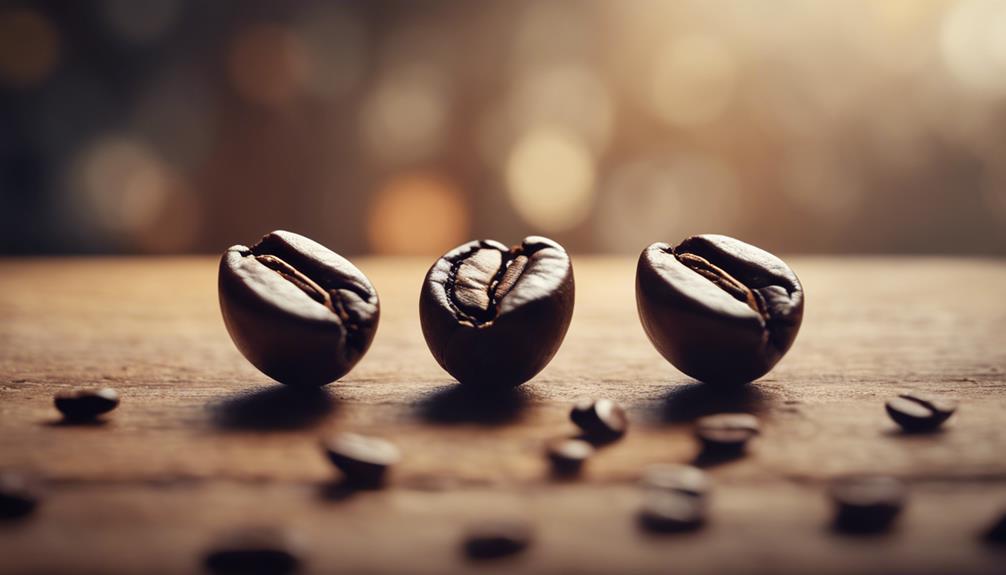
Roasting espresso beans to a darker level and grinding them to a finer texture are essential steps that set espresso apart from regular coffee. You may think it's just a matter of degree, but the difference is profound. Espresso beans are roasted longer and darker, resulting in a bolder flavor profile and a rich crema when brewed.
The grind size is also much finer, resembling sand, which is necessary for ideal extraction during the brewing process.
Here are some key things to keep in mind:
- A dark roast is necessary for bringing out the full flavor of espresso beans.
- The roasting process often reaches a second crack, releasing oils that contribute to the creamy texture and body of the final espresso drink.
- A proper grind allows for high-pressure extraction, where water is forced through the coffee grounds at around 130 lbs of pressure.
Brewing Methods and Flavor Profiles
You'll notice a dramatic shift in flavor profile and brewing time when you switch from traditional coffee to espresso, thanks to the distinct methods used to extract the ideal shot.
Espresso brewing methods involve high pressure, around 9 bars, to quickly extract flavors and create a rich crema on top. This differs considerably from traditional coffee brewing methods like drip, which rely on gravity and take longer to extract flavors.
The grind size for espresso is also finer, resembling a sandy texture, allowing for optimal extraction under high pressure. As a result, espresso's flavor profile is characterized by a bolder, less acidic taste, often with notes of chocolate and caramel.
In contrast, regular coffee can have a wider range of flavor notes depending on the brewing method and beans used. With espresso, you can expect a brewing time of 20-30 seconds, whereas coffee can take anywhere from 6 to 12 minutes.
This affects the overall flavor and strength of the final beverage. By understanding these differences in brewing methods and flavor profiles, you'll appreciate the unique qualities of espresso vs coffee.
The Art of Espresso Making at Home

Your journey to create authentic espresso at home begins with investing in an espresso machine that can deliver the necessary 9 bars of pressure, an essential factor in achieving ideal flavor extraction and a velvety crema.
With the right machine, you can experiment with different types of espresso beans and roasts to find your perfect cup.
To make espresso like a pro, you'll need to master the tamping process, ensuring even water flow during extraction.
Don't be discouraged if it takes some trial and error – the payoff is worth it!
Here are some tips to get you started:
- Invest in a high-quality home espresso machine that can deliver 9 bars of pressure.
- Experiment with different grind sizes and extraction times to perfect your taste and body.
- Practice steaming milk to create a rich, creamy texture for your lattes and cappuccinos.
Debunking Common Coffee and Espresso Myths
As you master the art of espresso making, it's equally important to separate fact from fiction and debunk common myths surrounding coffee and espresso. One of the most prevalent myths is that espresso and coffee beans are different. In reality, any coffee bean can be used for both, but the roasting process and grind size distinguish their use.
| Myth | Reality | Why it Matters |
|---|---|---|
| Espresso beans are different | Any coffee bean can be used | Understanding the roasting process and grind size is key |
| Espresso has more caffeine | Coffee has more caffeine overall | Don't assume espresso is always the stronger choice |
| Espresso is just stronger coffee | Unique brewing techniques and equipment required | Appreciate the art of espresso making |
| Espresso needs special beans | Roasting process and grind size make the difference | Experiment with different kinds of beans |
Frequently Asked Questions
Is Espresso Coffee Different Than Regular Coffee?
You're wondering if espresso is just regular coffee, but it's not! You'll notice a richer flavor, thicker consistency, and more caffeine in espresso, setting it apart from the coffee you brew at home every morning.
Does Espresso Affect You Differently Than Coffee?
You might wonder if espresso treats you differently than coffee. Well, its intense caffeine kick can give you a quicker energy boost, making you feel more alert and focused, but beware of the potential crash later on.
What Is Unique About Espresso Coffee?
You're wondering what makes espresso coffee unique – it's the precise 1:2 water-to-coffee ratio, high-pressure brewing, and dark roasts that create a thick, rich drink with a creamy crema and bold flavor profile that sets it apart.
Does Espresso Make Coffee Taste Different?
You might think it's just a stronger brew, but trust us, it's not! When you use espresso instead of regular coffee, you'll notice a deeper, richer flavor with a velvety texture that elevates your coffee game.
Conclusion
Now that you've uncovered the differences between coffee and espresso, you might be wondering: will you ever look at your morning cup the same way again?
From brewing techniques to roasting and grind size, every detail matters when it comes to bringing out the unique flavors and aromas of these beloved beverages.
So, what's next – will you become an espresso aficionado, or stick to your daily coffee grind?
The choice is yours, but one thing's for sure: your taste buds will thank you!


